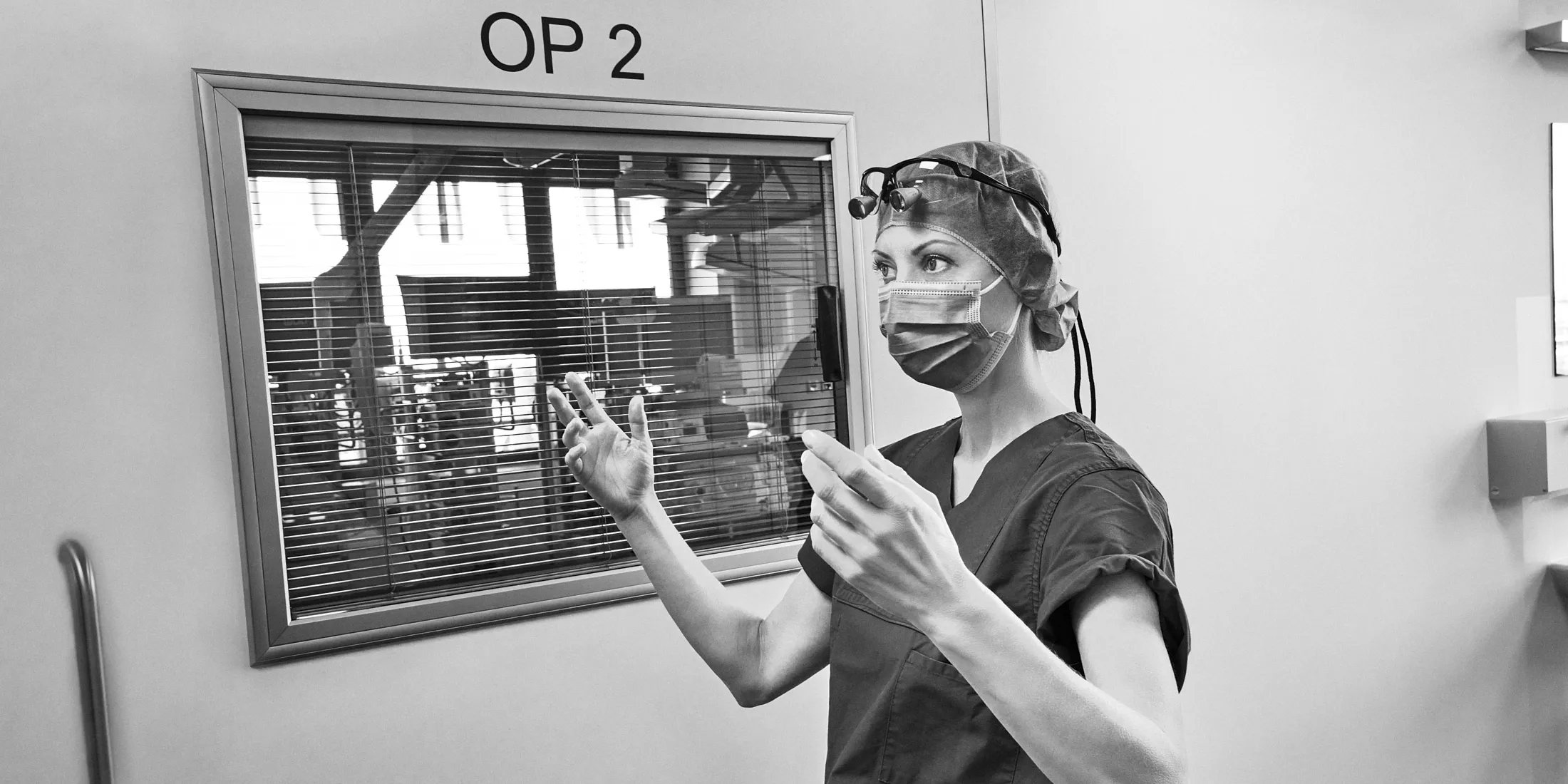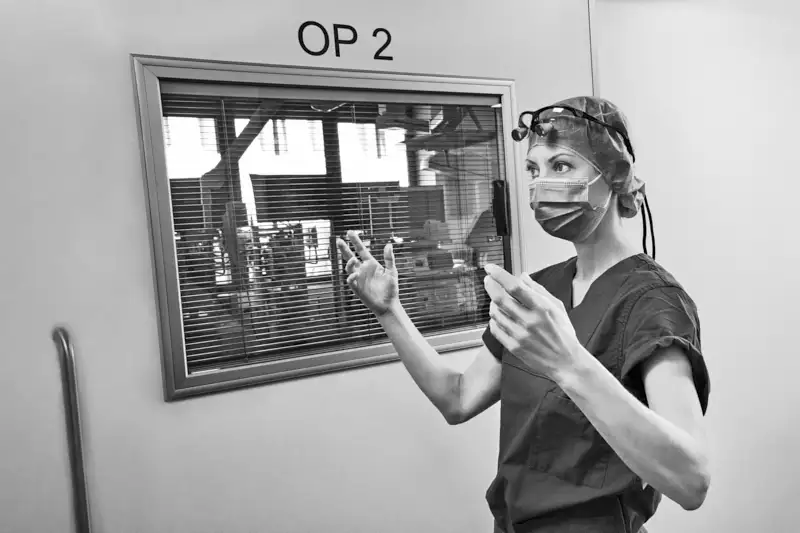Viszeralchirurgie Düsseldorf
Moderne Medizin trifft auf ganzheitliches Denken
Körper, Geist und Seele – fühlen wir uns auf allen Ebenen wohl, sind wir in ganzheitlicher Hinsicht gesund. Herzlich Willkommen, wir sind Ihre Spezialisten für Viszeralchirurgie und Ayurveda in Düsseldorf. Unsere ganzheitliche Betreuung verbindet moderne Diagnostik, innovative Therapien und einfühlsame Gespräche – ergänzt durch die aktivierende Kraft der ayurvedischen Medizin und das Ziel, Ihre Selbstheilungskräfte zu stärken.
Dr. med. Nina Picker
Fachärztin für
Viszeralchirurgie
„Sie abzuholen, an die Hand zu nehmen und Sie angstfrei durch die Behandlung zu führen.“ ~ Das ist mein Credo.
Spezialistin für
Ayurveda Medizin
„Durch die Kombination der Schul- und Komplementärmedizin entwickeln wir gemeinsam eine Therapie.“
Fachärztin für
Dr. med. Nina Picker
Viszeralchirurgie
„Sie abzuholen, an die Hand zu nehmen und Sie angstfrei durch die Behandlung zu führen“. ~ Das ist mein Credo.
Spezialistin für
Ayurveda Medizin
„Durch die Kombination der Schul- und Komplementärmedizin entwickeln wir gemeinsam eine Therapie.“
Unsere Spezialgebiete:
RKM 740 Allgemein- und Viszeralchirurgie Düsseldorf
Mit langjähriger Erfahrung in der operativen und konservativen Viszeralchirurgie sowie in der ayurvedischen Medizin bieten wir Ihnen im RKM 740 in Düsseldorf ein fundiertes und zugleich einfühlsames Behandlungskonzept, das moderne Medizin mit ganzheitlichem Denken verbindet.
Wir prüfen sorgfältig, ob eine Operation medizinisch notwendig ist – ganz gleich, ob es sich um einen minimalinvasiven Eingriff oder eine alternative Therapieform handelt. Ist eine Operation angezeigt, nehmen wir uns Zeit für eine ausführliche Aufklärung: Wir erklären Ihnen den Ablauf der Behandlung, die Art der Narkose und die stationäre oder ambulante Nachbehandlung – verständlich, individuell und menschlich.
Alle Eingriffe erfolgen in den OP-Räumen im RKM 740. Falls eine stationäre Versorgung notwendig ist, erfolgt die Unterbringung in unseren modern ausgestatteten Patientenzimmern mit persönlicher Betreuung.
Vor der Operation lernen Sie unser erfahrenes Anästhesie-Team im RKM 740 kennen, das Sie ausführlich über die Narkose informiert.
Ergänzend zur operativen Behandlung bieten wir im RKM 740 Ayurvedamedizin ein breites Spektrum ayurvedischer Therapien an – individuell kombinierbar für eine ganzheitliche Genesung von Körper, Geist und Seele.
Hernien Diagnostik
Anamnese
Körperliche Untersuchung:
Diagnose und Behandlungsmöglichkeiten
Bildgebende Verfahren
(z.B. Ultraschall, CT, MRT)
Husten- oder Belastungstest
Strategien zur Lösung komplexer Herausforderungen
Effektive Ergebnisse werden durch einen ganzheitlichen Ansatz bei der Diagnose und Behandlung von Hernien gewährleistet.
Hernien Chirurgie
Endoskopische, minimalinvasive Verfahren:
Offene Hernienchirurgie
Netzeinlage (Netzplastik)
Leistenhernien:
TEP (Totale extraperitoneale Hernioplastik)
TAPP (transabdominale präperitoneale Hernienplastik)
Shouldice-Technik
Lichtenstein-Technik
Nabel- und Bauchwandhernien:
Hernienversorgung mit und ohne Netz
Hernienchirurgie Nachsorge
Unsere Herniennachsorge:
Wundversorgung und Verbandswechsel
Narbenpflege und -behandlung
Tipps für eine optimale Wundheilung
Langzeitliche Beobachtung nach der OP
Ayurvedische OP Nachsorge:
Ergänzend bieten wir ayurvedische Behandlungen an, um Ihre Heilung zu unterstützen.
Gallenblasen Diagnostik
Anamnese
Körperliche Untersuchung:
Diagnose und Behandlungsmöglichkeiten
Blutuntersuchungen können erhöhte Werte auf Entzündungen oder Blockaden hinweisen.
Ultraschall erkennt Gallensteine, Entzündungen und Organveränderungen in der Gallenblase und den Gallenwegen.
Gallenblasen Chirurgie
Operationstechniken und moderne Verfahren:
Laparoskopische Gallenblasenentfernung
Offen-chirurgische Gallenblasenentfernung
Ayurvedische durch die OP:
Auf Wunsch bieten wir Ihnen eine ayurvedische Therapiebegleitung rund um Ihre Operation an.
Gallenblasen Nachsorge
Unsere Gallenblasennachsorge:
Wundversorgung und Verbandswechsel
Narbenpflege und -behandlung
Tipps für eine optimale Wundheilung
Langzeitliche Beobachtung nach der OP
Ayurvedische OP Nachsorge:
Ergänzend bieten wir ayurvedische Behandlungen an, um Ihre Heilung zu unterstützen.
Prof. Dr. med. Dietmar Simon
Ausgezeichneter Spezialist für endokrine Chirurgie – empfohlen von FOCUS Gesundheit und Stern/Statista (2025)
Schilddrüsen Diagnostik
Anamnese
Körperliche Untersuchung:
Diagnostische und therapeutische Möglichkeiten
Blutuntersuchung, Ultraschall, CT, MRT
SD Spezial Antikörper, spezifische Tumormarker, qualifizierte Sonographie
Unser ganzheitlicher Ansatz in der Diagnostik und Therapie von Schilddrüse, Nebenschilddrüse und Nebenniere optimiert effektive Ergebnisse.
Schilddrüsen Chirurgie
Operationstechniken und moderne Verfahren:
Endoskopische, minimal-invasive Eingriffe:
Lymphknotendissektion/ Lymphknoten Entfernung
Schlüsselloch-Chirurgie
Offene Schilddrüsenchirurgie
Kropf- oder Knotenoperation
Ayurvedisch durch die OP:
Auf Wunsch bieten wir Ihnen eine ayurvedische Therapiebegleitung rund um Ihre Operation an.
Schilddrüsen Nachsorge
Unsere Schilddrüsen Nachsorge:
Funktionsprüfung
Wundversorgung und Verbandswechsel
Narbenpflege und -behandlung
Tipps für eine optimale Wundheilung
Langzeitliche Beobachtung nach der OP
Ayurvedische OP Nachsorge:
Ergänzend bieten wir ayurvedische Behandlungen an, um Ihre Heilung zu unterstützen.
Weitere Fachgebiete Allgemein- & Viszeralchirurgie
Nebennieren Chirurgie
Individuelle Nebennierenchirurgie: Optimale Lösungen für Ihre Hormonbalance …
Koloproktologie
Die Gesundheit des Beckenbodens und des Darms im Fokus: Koloproktologische Lösungen für mehr Lebensqualität…
Konservatives Spektrum
Zeit für den Menschen – Individuelle Therapieentwicklung bei komplexen Krankheitsbildern und chronischen Erkrankungen…
Vitalstoffinfusion
Sie sind erschöpft, gestresst, dauermüde oder anfällig für Infekte? In unserer schnelllebigen Zeit kein Wunder. Ständige Höchstleitungen…
In unserer Praxis im RKM 740 Viszeralchirurgie und Ayurvedamedizin haben wir eine Umgebung geschaffen, in der Sie sich in einer harmonischen und beruhigenden Atmosphäre bewegen können. Durch gezielt gesetzte Akzente integrieren wir Elemente der vedischen Architektur, die heilende Wirkung von Farben und Kunstwerken – mit dem Ziel, Ihre Selbstheilungskräfte zu aktivieren und Ihnen ein Gefühl der Geborgenheit zu vermitteln.
Die ruhigen, minimalistisch gestalteten Räume unserer Praxis wirken wie ein geschützter Ort – ein moderner Safe-Space für Ihre ganzheitliche Behandlung.
Die RKM 740 Klinik befindet sich im selben Gebäude und kombiniert modernste Medizintechnik mit einem sorgfältig abgestimmten Design- und Farbkonzept. Unser erfahrenes und engagiertes Pflegepersonal sorgt dafür, dass Ihr Aufenthalt nicht nur medizinisch optimal begleitet, sondern auch wohltuend und erholsam ist – für Körper, Geist und Seele.
Das sagen unsere Patienten
Eine außergewöhnliche, herausragende und unbeschreiblich liebe Ärztin.
Ich fühlte mich vom ersten Moment an kompetent und sicher aufgehoben.
Umfangreiche Untersuchung, bei der mir alles gut und verständlich erklärt wurde. Die Angst vor der OP wurde mir komplett genommen. Die Nachbetreuung war ebenfalls hervorragend.
Frau Dr. Picker ist wirklich überragend und zu 1000% weiterzuempfehlen.
Frau Dr. Picker ist eine sehr einfühlsame Ärztin, die sich sehr viel Zeit nimmt.
Im April habe ich mich bei Frau Dr. Picker operieren lassen an der Schilddrüse.
Ich habe mich sehr gut aufgehoben gefühlt….sowie vor und nach der OP.
Auch ein großes Dankeschön an den stationären Aufenthalt und natürlich dem dazugehörigen Team.
Das Wort Krankenhaus bekommt eine neue Bedeutung und ähnelt mehr einem Wellness Aufenthalt. Top
Frau Dr. Picker ist eine besondere Ärztin für mich. Sie hat sich Zeit genommen und mich mit Geduld und Ruhe, sehr kompetent behandelt.
Nach 15 Jahren chronischer Darmkrankheit, kann ich mich durch die empfohlene Therapie, beschwerdefrei wohlfühlen.
Ich kann es kaum glauben und möchte Frau Dr. Picker uneingeschränkt weiterempfehlen.
Die Praxis ist sehr gut organisiert und das ganze Personal sehr zuvorkommend.
Super Ärztin, freundlich und kompetent. Auch die Organisation war perfekt. In der Praxis herrschte eine entspannte Stimmung. Obwohl viel los war, war von Stress und Hektik nichts zu spüren.
Besonders bemerkenswert, dass auch die Arzthelferinnen sehr engagiert und hilfsbereit waren, sich Zeit nahmen und alles perfekt vorbereiteten.
Weitere Bewertungen finden Sie auf Jameda.de

Erfahrungsberichte unserer Hernienpatienten
Die Stimmen einiger unserer Patienten geben Einblick in ihre persönlichen Erfahrungen mit der Hernienbehandlung und ihrem Aufenthalt im RKM740 Hernien-Zentrum in Düsseldorf.
UNSER RKM 740 AYURVEDA ZENTRUM Düsseldorf
Entdecken Sie unser Ayurveda-Angebot im RKM 740
Dr. med. Nina Picker verwirklicht im RKM 740 Düsseldorf ein innovatives Konzept ganzheitlicher medizinischer Versorgung, das Viszeralchirurgie und Ayurvedamedizin auf besondere Weise miteinander verbindet. Durch die Kombination von Schulmedizin und Ayurveda entstehen individuelle und erfolgversprechende Behandlungsmöglichkeiten – für Menschen, die eine umfassende und nachhaltige Heilung anstreben.
Ayurveda ist ein traditionelles, ganzheitliches Heilsystem, das Körper, Geist und Seele gleichermaßen berücksichtigt. Ihr Gleichgewicht gilt als Grundlage für Wohlbefinden und Gesundheit. Ziel der ayurvedischen Medizin ist es, den Menschen auf sanfte Weise zur Gesundheit zurückzuführen – und dabei einen gesunden Organismus im Einklang mit sich selbst und der Natur zu erhalten.
Die Behandlung ist immer individuell. Zum Einsatz kommen natürliche Methoden wie ayurvedische Kräuterheilkunde, Ernährungsumstellung, Marma-Therapie, Massagen, Yoga und Meditation. Sie stärken die Selbstheilungskräfte und helfen, die Doshas – die Energieprinzipien im Körper – wieder ins Gleichgewicht zu bringen.
Ayurvedamedizin
• Was ist Ayurveda? • Die Doshas: Vata, Pitta und Kapha • Ganzheitlicher Ansatz
Marmatherapie
• Vitalpunkte • Sukshma Marma Therapie® • Wiederherstellung des Gleichgewichts der Lebensenergie
Ernährungsberatung
• Wir helfen, umzudenken • Spezifische Beratungen • Gewichtsmanagement • Ernährungsplan
Ayurveda & Chirurgie
• Ayurvedische Ergänzungen zur Kombination mit operativer Behandlung
Panchakarma-Kuren
Panchakarma-Refresher
Ayurvedisch Abnehmen
Immunbooster-Kur
Wechseljahre-Kur
Detox-Kur
Einzelbehandlungen
Atemwegserkrankungen
Long Covid
Burnout
Immunschwäche
Viszerales Fett
Magen-Darm-Erkrankungen
Post-Chemo-Aufbaukur
Kontakt
Kontakt
Adresse
| Viszeralchirurgie & Ayurvedamedizin |
| Pariser Str. 89 |
| 40549 Düsseldorf |
Ihr Weg zu uns
| Anfahrt mit PKW oder ÖPNV |
Sprechzeiten
| Montag | 09:00 bis 17:00 |
| Dienstag | 09:00 bis 17:00 |
| Mittwoch | 09:00 bis 16:00 |
| Donnerstag | 09:00 bis 19:00 |
| Freitag | 09:00 bis 16:00 |




















